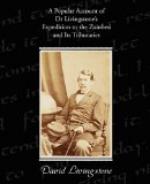We emerged from the thirty-five or forty miles of Kebrabasa hills into the Chicova plains on the 7th of June, 1860, having made short marches all the way. The cold nights caused some of our men to cough badly, and colds in this country almost invariably become fever. The Zambesi suddenly expands at Chicova, and assumes the size and appearance it has at Tette. Near this point we found a large seam of coal exposed in the left bank.
We met with native travellers occasionally. Those on a long journey carry with them a sleeping-mat and wooden pillow, cooking-pot and bag of meal, pipe and tobacco-pouch, a knife, bow, and arrows, and two small sticks, of from two to three feet in length, for making fire, when obliged to sleep away from human habitations. Dry wood is always abundant, and they get fire by the following method. A notch is cut in one of the sticks, which, with a close-grained outside, has a small core of pith, and this notched stick is laid horizontally on a knife-blade on the ground; the operator squatting, places his great toes on each end to keep all steady, and taking the other wand which is of very hard wood cut to a blunt point, fits it into the notch at right angles; the upright wand is made to spin rapidly backwards and forwards between the palms of the hands, drill fashion, and at the same time is pressed downwards; the friction, in the course of a minute or so, ignites portions of the pith of the notched stick, which, rolling over like live charcoal on to the knife-blade, are lifted into a handful of fine dry grass, and carefully blown, by waving backwards and forwards in the air. It is hard work for the hands to procure fire by this process, as the vigorous drilling and downward pressure requisite soon blister soft palms.




